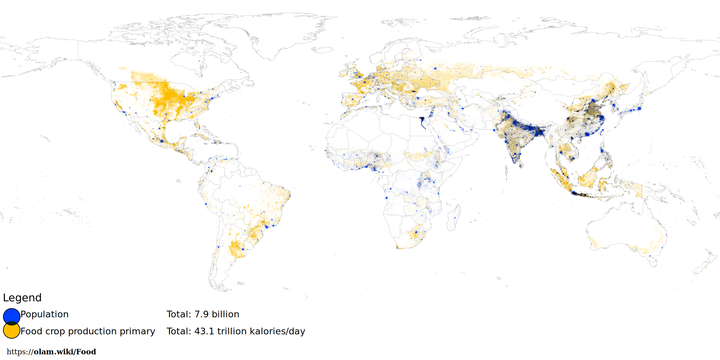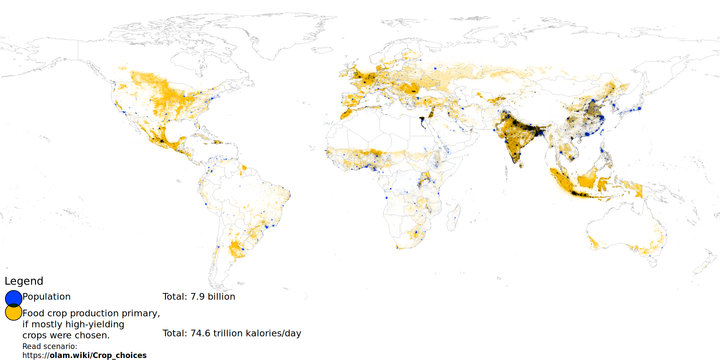Crop choices
One way to increase crop yields is to simply grow different crops.
Which crops get the highest yields? The answer is different in every region of the world. See this chart for all crops and all countries. Note: the page is quite big and may be slow to load.
Scenario overview
Let's explore a hypothetical scenario in which every country grows mainly its highest-yielding crops.
Some key findings:
- Globally, total crop yields would be almost doubled.
- In Africa, total crop yields would be tripled.
- The food supply would be more nutritionally balanced.
(...)( When comparing the nutritional content of 2250 kalories of food: The status quo does not meet the daily recommendations for potassium, calcium, vitamin A, vitamin D, vitamin E, vitamin K, vitamin B5 (pantothenate) and vitamin B12. Whereas 2250 kalories of the new scenario's foods would meet the daily requirements for all nutrients except vitamin D (normal for food in general) and vitamin B12 (normal for unfermented plant-based foods) ) - There would be far more fruits & vegetables (which vary widely by region).
(...)( So many, in fact, that they provide the bulk of calories & protein in the diet. It's not possible for a human to eat this many fruits & vegetables in their raw form. But they could be transformed into juices, concentrates, or even flours to be used in baked goods. Food ingredients would certainly look a lot different in this scenario. ) - But some food choices are very questionable - such as ridiculously large amounts of garlic & chili peppers.
(...)( We're talking a whole pound of garlic+chilis per person per day. The sheer volume of this provides a significant amount of protein & calories in the diet. But for this to actually work in real life, there would probably have to be some kind of processing to remove most of the pungency (capsaicin, allicin, etc) because otherwise it would just be too much for anyone to handle. In a way, this would be similar to how today's food supply is based on grains that need to be cooked to destroy antinutrients. Garlic & chili probably get high yields because they're too pungent for most pests to eat. )
Food crop production
For a detailed breakdown by country, see this page.
The links below show the crops as foods in the nutrition calculator, as food per day per capita. Note: this is primary production, which is significantly higher than what people actually eat.
Nutrition calculator links
| World: | before | after |
| Africa: | before | after |
| Asia: | before | after |
| Europe: | before | after |
| North America: | before | after |
| Oceania: | before | after |
| South America: | before | after |
Labor and economics
The scenario involves a lot fruits & vegetables which are currently more expensive (per calorie) than grains. If the costs have anything to do with farm labor, then we're looking at a scenario that would require a lot more people to work in agriculture. Or maybe not, if the high prices of fruits/vegetables have more to do with grocery stores keeping them fresh. Consider how some countries can make sugar cheaply from sugar beets (a root vegetable, in some sense). Perhaps we could make similarly cheap products (but hopefully more nutritious than sugar!) from abundant produce.

